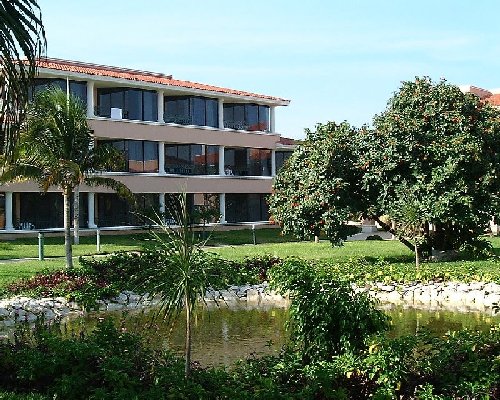|
|
CANCUN
Hi, Welcome to Cancun Mexico
Cancun, meaning 'the
little ship at the end of the rainbow' in the ancient Mayan language, is a
modern, purpose-built resort. Cancún offers a exotic, tropical island setting buoyed by modern
comforts and conveniences. A well-planned layout and infrastructure give the destination a polished (though somewhat un-Mexican)
appearance. Shopping is really good but we found it a little on the
expensive side, with over a dozen American-style shopping malls.
There are over 200 restaurants with many dining options which include every imaginable fast food chain along with
gourmet seafood, Asian, Caribbean, American and Mexican specialties. And of course, outdoor recreation (water sports, in particular) is
really good. Cancún succeeds in combining the best of Mexico and the Caribbean into one tidy package.
The Mayan Influence
The area's history is rich with Mayan influence. It has been periodically occupied for hundreds of years. Stone temples uncovered during the resort's construction date back to the 12th century. Further inland are magnificent ancient cities and ceremonial centers. Over 200 archaeological sites, some wonderfully restored, others still shrouded with tangled jungle vegetation are scattered within a few hours drive from Cancun.
The Moon Palace Resort
This has to be the best hotel complex we have ever stayed in. This hotel has everything for everybody. So many restaurants serving different culinary of food. So many activities on offer, you would never get bored and the swimming pools are the largest freshwater pools in Cancun. The design and location has been well thought out with emphasis on quality and comfort..

This is the view from our room
 Rick and Jan
Rick and Jan
Chichen -Itza
This archaeological city of the state of Yucatan was founded by the Maya-Itzas who came led by Itzamna after separating from Acalon. They arrived in the Peninsula around the year 435-455 A.D..
Chichen was occupied twice. The first occupation was from 495 to 692, and the second from 948 to 1204. The architecture of the first period is considered to be authentically Maya, and the second is considered to have Toltec influence, since it has certain elements in common with those found in Tula, the ancient capital of the Toltec-Hueytlapalanecas.
The zone measures 3 kms from North to South and 2 kms from West to East. This zone contains so many constructions that it gives us an idea of how important this city was to the Maya. In general these buildings can be divided into two groups, according to the era in which they were built:
 Those
of the Classic Maya period, which covers the Seventh to Tenth centuries. In this
group these buildings are found: The Nunnery and its annexes, the Akab Dzib, the
Temple of the three lintels, the Red House , that of the Phallus and that of the
Deer. In the Maya Toltec group constructed between the Tenth century and the
Thirteenth century, we have the Castle, The Temple of the Warriors , the Ball
Court, the Thousand Columns group, the Tzopantli, the Osary , the platforms of
Venus and of the Tigers and of the Eagles. The Astronomical Observatory (Caracol)
belongs to a transition phase. The city has as its main axis two cenotes ,
Xtoloc, which provided the city with water, and the Sacred Cenote, where
offerings of maidens and children were made to the gods. It has a diameter of 60
meters with a depth of to the water of 12 meters. In 1900, the North American,
Edward Thompson, who lived in the Hacienda Chichen extracted a multitude of
objects from this cenote. Other explorers who studied Chichen were: Francisco
Montejo, "The Advanced", the conqueror of Yucatan in 1527; Stephens
and Caterwood, in 1841-42,; Le Plongeon in 1875; Maudslay, Maler and others took
care of divulging this Maya city to the world .
Those
of the Classic Maya period, which covers the Seventh to Tenth centuries. In this
group these buildings are found: The Nunnery and its annexes, the Akab Dzib, the
Temple of the three lintels, the Red House , that of the Phallus and that of the
Deer. In the Maya Toltec group constructed between the Tenth century and the
Thirteenth century, we have the Castle, The Temple of the Warriors , the Ball
Court, the Thousand Columns group, the Tzopantli, the Osary , the platforms of
Venus and of the Tigers and of the Eagles. The Astronomical Observatory (Caracol)
belongs to a transition phase. The city has as its main axis two cenotes ,
Xtoloc, which provided the city with water, and the Sacred Cenote, where
offerings of maidens and children were made to the gods. It has a diameter of 60
meters with a depth of to the water of 12 meters. In 1900, the North American,
Edward Thompson, who lived in the Hacienda Chichen extracted a multitude of
objects from this cenote. Other explorers who studied Chichen were: Francisco
Montejo, "The Advanced", the conqueror of Yucatan in 1527; Stephens
and Caterwood, in 1841-42,; Le Plongeon in 1875; Maudslay, Maler and others took
care of divulging this Maya city to the world .
